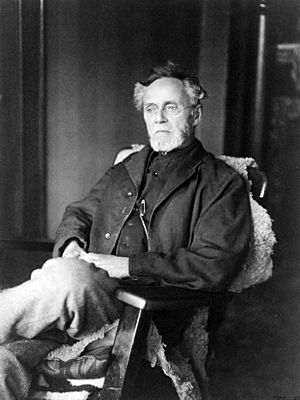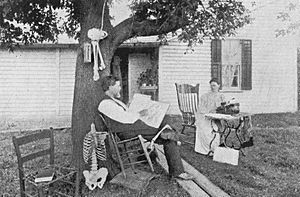Andrew Taylor Still facts for kids
Quick facts for kids
Andrew Taylor Still
|
|
|---|---|

Andrew Taylor Still in 1914
|
|
| Born | August 6, 1828 Lee County, Virginia, United States
|
| Died | December 12, 1917 (aged 89) Kirksville, Missouri, United States
|
| Nationality | American |
| Citizenship | United States |
| Scientific career | |
| Fields | Medicine Osteopathy Osteopathic Medicine |
| Institutions | Baker University A.T. Still University |
Andrew Taylor Still (born August 6, 1828 – died December 12, 1917) was an American doctor. He is famous for creating osteopathic medicine. He was also a surgeon, writer, and inventor. Still served as a lawmaker in Kansas when it was a territory and later as a state. He helped start Baker University, which is the oldest four-year college in Kansas. He also founded the American School of Osteopathy (now A.T. Still University). This was the world's first school for osteopathic medicine, located in Kirksville, Missouri.
Contents
Early Life and New Ideas
Andrew Taylor Still's father was both a Methodist minister and a physician. From a young age, Andrew wanted to be a doctor like his father. He studied medicine and learned from his father.
During the American Civil War, he worked as a hospital steward. This job was like a medical assistant. Hospital stewards helped keep the hospital running. They managed supplies, filled prescriptions, and cared for patients when doctors were not there. Still later said he acted as a "de facto surgeon," meaning he performed duties like a surgeon.
After the Civil War, Still faced a great tragedy. In 1864, his wife, three of his children, and an adopted child died from spinal meningitis. This sad event made Still question the medical practices of his time. He felt that many treatments were not working and sometimes even caused harm. For example, doctors often used a drug called Calomel (mercury chloride). There were no rules for how much to give, so patients often got too much. This could lead to mercury poisoning.
Still decided to find better ways to treat disease. For the next 30 years, he studied the human body very closely. He dissected bodies to understand their structure and how they worked. He wanted to find natural ways for the body to heal itself. In 1870, he took a short medical course in Kansas City. Around 1867, Still also became interested in spiritualism. This was a belief that spirits of the dead could communicate with the living. This idea stayed important in his thinking.
Lawmaker in Kansas
Still was very active in the movement to end slavery, called abolitionism. He was friends with important anti-slavery leaders like John Brown. Still was deeply involved in the fight over whether Kansas would become a state where slavery was allowed or forbidden.
The Kansas–Nebraska Act of 1854 said that people living in these territories could choose for themselves. This led to a lot of fighting in Kansas, known as Bleeding Kansas. Both sides fought to control the government. In October 1857, Still was chosen to represent Douglas and Johnson counties in the Kansas government. He and his brothers even took up arms to fight for the cause. By August 1858, a constitution against slavery was passed. Kansas officially became a free state on January 29, 1861.
Inventor
Andrew Taylor Still loved machines and solving problems. He always tried to find better ways to do things. In the 1870s, he received a patent for an improved butter churn. He also made improvements to a machine that cut wheat and hay. However, his idea was stolen before he could get a patent for it. In 1910, he patented a special burner for a smokeless furnace. But after his wife, Mary Elvira, died in May 1910, he lost the desire to work on it. So, this invention was never sold successfully.
Founding Baker University
Still and his family were among the people who started Baker University in Baldwin City in 1858. This was the first four-year university in Kansas. Still helped choose the spot for the university's first building. He and his brother gave 640 acres of land for the campus. While still working as a doctor and treating patients with diseases like small-pox and cholera, Still spent five years helping to build the university's facilities.
Osteopathy: A New Way to Heal
Still believed that the medical practices of his time often caused more harm than good. He felt that traditional medicine had not found the true causes of diseases. In the 1800s, medicines, surgeries, and other treatments often made people worse. Also, surgical tools were not clean, which led to many deaths.
Still wanted to change how medicine was practiced. He looked into other treatments like water therapy (hydropathy), special diets, and bone setting. He liked that these methods had fewer bad side effects. He imagined a future where doctors would mostly use manipulation of the musculoskeletal system (bones, muscles, and joints). They would use surgery and only a few drugs, like those for pain or to fight germs.
Still created the name osteopathy. It comes from two Greek words: osteon- meaning "bone" and -pathos meaning "suffering." He believed that many diseases started because the body's bones and muscles were not working correctly. By fixing problems in the musculoskeletal system, he thought doctors could treat many illnesses. This would also help patients avoid the bad side effects of strong drugs.
In 1892, Still opened the first school based on his new ideas. It was called the American School of Osteopathy (now A.T. Still University) in Kirksville, Missouri.
Still was also one of the first doctors to promote preventive medicine. This is the idea that doctors should help people stay healthy to avoid getting sick. He believed doctors should focus on treating the cause of a disease, not just its symptoms.
Still described osteopathy as:
a science that has exact and deep knowledge of how the human body works. This includes its anatomy (structure), physiology (how it functions), and psychology (mind). It also looks at the chemistry and physics of the body. This knowledge helps discover natural laws and ways the body can heal itself. With osteopathic treatment, the body can recover from problems and get back to its normal healthy state.
In 1907, Still's son, Charles Still, also a doctor, talked about his father's ideas. He said his father believed the body could work well into old age if it was cared for properly. He also thought that every living thing could make all the chemicals and materials it needed to heal itself.
See also
 In Spanish: Andrew Taylor Still para niños
In Spanish: Andrew Taylor Still para niños
- S. S. Still—Andrew Taylor Still's nephew, who was also an osteopath and taught at A. T. Still University.


